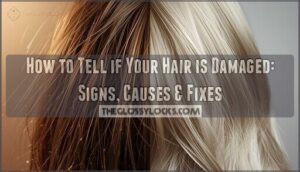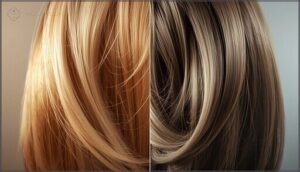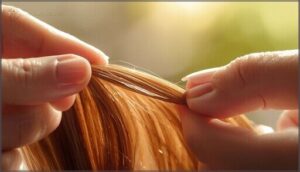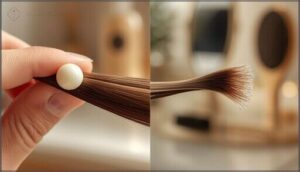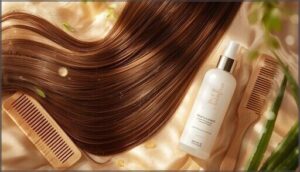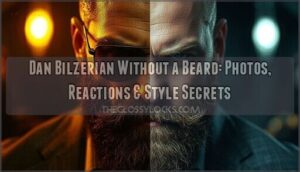This site is supported by our readers. We may earn a commission, at no cost to you, if you purchase through links.
Run your fingers through your hair, and you’ll know instantly if something’s off. That scratchy, straw-like feeling? It’s not just from a bad hair day—it’s your strands sending an SOS. Damage doesn’t always announce itself with dramatic breakage or split ends.
Sometimes it starts quietly: hair that won’t hold a curl anymore, tangles that appear out of nowhere, or that dull, lifeless look no amount of product can fix. Understanding what healthy hair should feel like—smooth, elastic, with a natural sheen—gives you the baseline to spot trouble early.
Once you know the telltale signs, you can stop guessing and start taking action before minor wear turns into major repair work.
Table Of Contents
- Key Takeaways
- How to Tell if Your Hair is Damaged
- Common Signs of Hair Damage
- Causes of Hair Damage
- How to Assess Hair Texture and Elasticity
- Identifying Hair Breakage and Split Ends
- Recognizing Dullness and Loss of Luster
- Treating and Repairing Damaged Hair
- Preventing Future Hair Damage
- Frequently Asked Questions (FAQs)
- Can damaged hair be repaired?
- What Does Healthy Hair Feel Like?
- Can I use coconut oil on damaged hair?
- Will damaged hair have healthy growth?
- What does very damaged hair look like?
- What are some treatments for damaged hair?
- How can you prevent damage to your hair?
- Can damaged hair ever fully recover naturally?
- How long does hair repair typically take?
- Can sleeping habits contribute to hair damage?
- Conclusion
Key Takeaways
- Your hair signals damage through texture changes like roughness, brittleness, and lost elasticity—healthy strands should feel smooth, stretch without snapping, and bounce back naturally.
- Split ends, excessive tangling, dullness, and breakage aren’t just cosmetic issues—they’re warning signs that your hair’s protective cuticle layer has been compromised by heat, chemicals, or environmental stress.
- Repairing damaged hair requires a balanced approach of moisture through deep conditioning masks, strength through protein treatments, and regular trims to prevent split ends from traveling up the hair shaft.
- Prevention beats repair every time—limit heat styling to 2-3 times weekly, always use heat protectants, space out chemical treatments, and choose gentle styling tools like wide-tooth combs and silk scrunchies.
How to Tell if Your Hair is Damaged
Your hair won’t always announce when it’s damaged, but it will leave clues. Learning to spot these signs early helps you take action before the damage becomes severe.
Let’s walk through the key changes that signal your hair needs attention.
Changes in Hair Texture
Your hair’s texture tells a story. When it shifts from smooth to rough, that’s your first clue something’s wrong. Watch for these changes:
- Roughness increase – Strands feel coarse or scratchy instead of soft
- Elasticity loss – Hair snaps easily when stretched, signaling brittleness
- Diameter changes – Ends feel thinner than roots, showing wear
- Porosity changes – Hair absorbs water too fast, dries unevenly, and tangles constantly
Cuticle degradation causes that straw-like, dry, dull texture you’re feeling.
Loss of Natural Shine
Shine fades when cuticle integrity breaks down. You’ll notice a dull appearance instead of the glossy finish healthy hair shows. UV depletion strips protective oils, while surface deposits from product buildup dim your hair’s natural luster.
Research links the biomarker COL7A1 to cuticle damage and shine loss. Some studies show supplement intervention improves hair shine by over 50% in 84 days, proving dullness signals real damage.
Increased Hair Tangling
Beyond that missing gloss, tangled and rough hair signals deeper trouble. When cuticle damage lifts those protective scales, cuticle friction jumps fourfold—your strands snag instead of gliding past each other. Hair morphology plays a role too: curly textures loop back, forming knots naturally. Moisture balance matters, since dry strands cling and catch.
Managing tangled hair starts with detangling practices like wide-tooth combs and working from ends upward, preventing excessive tangling and breakage.
Unusual Hair Shedding
When your brush suddenly fills with clumps rather than a handful of strands, you’re seeing signs of hair damage worth watching. Healthy adults shed fifty to one hundred hairs daily—anything beyond one hundred fifty signals excessive shed. Here’s what separates normal hair loss from trouble:
- Hair shedding thresholds: Consistently losing over two hundred hairs per day suggests telogen effluvium or underlying issues requiring evaluation.
- Seasonal patterns: August shedding can double March levels, reaching sixty hairs daily—a natural hair cycle shift.
- Clinical indicators: Persistent hair breakage or hair shedding lasting beyond three months, especially with shortened hair strands rather than shed hair showing white bulbs, points toward damage needing professional assessment.
Common Signs of Hair Damage
Once you suspect your hair might be damaged, the next step is learning to spot the telltale signs. Damaged hair shows up in ways that are easy to recognize once you know what to look for.
Here are the most common indicators that your hair needs some extra attention.
Dry or Brittle Hair
If your strands feel rough and snap easily, you’re dealing with dry or brittle hair—one of the clearest red flags of hair damage. This brittle texture signals protein loss from UV damage, reduced scalp oil production, or genetic factors that limit natural hair moisture. Environmental stressors and frequent heat styling strip away protective oils, leaving your hair vulnerable to breakage.
| Cause | What Happens | Result |
|---|---|---|
| UV exposure | Oxidizes hair proteins | Rough, rigid texture |
| Reduced sebum | Less natural lubrication | Persistent dryness |
| Heat styling | Strips moisture rapidly | Increased breakage |
| Age factors | Sebaceous glands slow | Progressive dryness |
Treating damaged hair starts with restoring what’s been lost—deep conditioners and protein treatments rebuild strength while hydrating masks seal in essential moisture.
Split Ends
Split ends—medically termed trichoptilosis—are irreversible signs of hair damage where the shaft frays into two or more fragments. Mechanical damage from brushing, chemical services like bleaching, and heat styling all strip the protective cuticle, exposing the cortex beneath. You’ll spot classic Y-shaped splits or feathered tips.
Treating damaged hair requires regular trimming every 6–8 weeks, plus preventive care with heat protectants to control hair breakage.
Frizz and Flyaways
Why do frizzy strands and flyaways appear after heat styling or chemical damage? When hair cuticles lift—from bleaching, harsh relaxers, or flat irons above 200 °C—surface roughness increases by up to 45%, triggering friction and unruly texture. Humidity effects worsen the chaos, causing swelling and fly-aways.
Three proven fixes:
- Apply antifrizz serum to seal lifted cuticles
- Use surface treatments that restore gloss
- Reduce mechanical stress with wide-tooth combs
Combat dryness and dullness before frizz worsens.
Hair Feels Thicker at Roots, Thinner at Ends
Ever notice your hair feels thicker near the scalp but thins dramatically at the tips? That’s cumulative hair damage in action. Your ends have survived years of stress factors—heat, combing, UV exposure—while roots are brand new.
Split ends and hair breakage expose the hair cuticle, reducing diameter by up to 27%.
Poor nutrient delivery and the natural growth cycle worsen end thinning causes and hair fragility.
Causes of Hair Damage
Now that you know what damaged hair looks like, let’s talk about what’s actually causing the problem.
Your daily habits, the products you use, and even the water you wash with can all play a role. Understanding these common culprits will help you protect your hair and prevent further damage.
Heat Styling Tools
Your flat iron might be destroying your hair without you realizing it. Temperature thresholds above 175°C permanently alter your hair’s structure, yet most styling tools reach 232°C or higher. Heat damage strips moisture retention and fractures your cuticles with each pass.
That’s why heat protectant sprays and thermal protectants matter—they create a barrier between your strands and extreme temperatures, especially if you’re styling frequently.
Chemical Treatments and Coloring
Chemical damage strips away the protein your hair needs to stay strong. Bleaching dissolves your hair’s melanin and creates a porous, brittle structure that breaks easily. Hair color maintenance isn’t just cosmetic—repeated dye applications reduce alpha-keratin levels in your shaft.
- Relaxer risks include scalp irritation, burns, and up to 67% of users experiencing thinning
- Protein loss accelerates when you combine straightening with bleach damage
- Dye effects worsen with frequency, causing permanent texture changes and weakness
Hair color protection starts with spacing treatments farther apart.
Environmental Exposure (Sun, Hard Water, Pollution)
Your surroundings damage hair in ways you can’t always see. UV exposure degrades hair proteins, shrinking shaft diameter and fading color—just 4.5 hours in the sun creates measurable harm.
Hard water deposits minerals that reduce tensile strength, making strands snap under stress.
Pollution carves fissures into your cuticle, disrupting growth proteins.
Combined exposure accelerates brittleness, dullness, and tangling faster than any single environmental stressor alone.
Lack of Moisture and Protein Imbalance
Beyond external threats, internal imbalance destroys hair from within. Your strands need equal parts moisture retention and protein to maintain hair elasticity—too much of either creates visible signs of damaged hair. Moisture-starved fibers snap on contact, while protein overload leaves hair stiff and brittle.
High porosity effects worsen the cycle, causing rapid water loss that prevents balance restoration. Protein treatments and deep conditioning work together for effective hair repair.
How to Assess Hair Texture and Elasticity
Healthy hair should stretch slightly when pulled and bounce back without snapping. If your strands break easily or feel limp, that’s your hair telling you it needs help.
You can check your hair’s strength and flexibility with a few simple tests that reveal exactly what’s going on beneath the surface.
Brittle Vs. Flexible Strands
How do you know if your strands bend or snap? Healthy hair flexes because it holds enough moisture—up to 40% of its weight in water—while damaged hair lacks hydration levels and mechanical strength, making it brittle.
Signs of damaged hair include:
- Weak brittle texture that snaps instead of stretching
- Poor hair elasticity with minimal bounce-back
- Cuticle condition showing roughness and increased friction
- Hair breakage during routine combing or styling
- Protein structure compromised by chemical treatments
Wet brittleness also signals trouble when strands fracture easily after washing.
Snap Test for Hair Strength
You can check your hair’s resilience with a simple test procedure: hold a single strand between your fingers and gently pull. Healthy hair stretches about 30% before snapping, while damaged hair breaks immediately with minimal tension.
This weak, brittle texture signals structural damage from heat or chemicals.
Wet strands should flex even more than dry ones—if they snap right away, you’re seeing clear damage indicators.
High Porosity and Absorption Issues
High porosity hair pulls water in fast but can’t hold it—you’ll notice your strands soak up products instantly, then turn dry and frizzy within hours. This absorption issue comes from damaged cuticles that create gaps in your hair shaft.
- Moisture loss: Water evaporates quickly, leaving hair brittle
- Chemical absorption: Dyes and treatments penetrate unevenly
- Structural weakness: Protein loss weakens each strand
- Lipid depletion: Natural oils escape, increasing hair breakage
Hair repair starts with sealing those gaps.
Identifying Hair Breakage and Split Ends
Breakage and split ends are two of the clearest signs that your hair is damaged, and they often show up before other symptoms become obvious. Learning to spot these issues early helps you address them before they get worse.
Here’s what to look for when checking your hair for breakage and split ends.
Visual Signs of Split Ends
Split ends appear as a single strand dividing into a “Y” or “V” shape—that’s the classic end morphology you’ll spot during home inspection. Studies show split prevalence affects roughly 8% of people, but it’s more common with longer hair.
Look for fuzzy, frayed tips sticking out from a loose braid. These signs of hair damage signal your strands need attention before breakage worsens.
Short Broken Hairs and Uneven Lengths
Short, uneven strands appearing mid-shaft or near your hairline signal breakage—not natural variation. Studies confirm a 40% breakage prevalence in damaged hair, with areas facing frequent styling showing the highest concentration of broken pieces.
Look for these signs of hair damage:
- Strands ranging from less than an inch to several below normal length
- Rougher texture and visible frizz in affected zones
- Shorter hairs collecting on clothing or pillows
- Thinned-out patches compared to healthier sections
Contributing factors include heat styling, tight hairstyles, and chemical treatments. Measurement techniques like the Hair Breakage Index reveal diameter differences between root and tip.
Recovery trends show that preventing hair breakage requires trimming damaged ends and protecting strands—treatments for damaged hair and proper hair damage repair routines restore even growth over time.
Differences Between Shedding and Breakage
Your scalp naturally releases 50 to 100 strands daily—that’s shedding. Hair breakage snaps mid-shaft from stress or damage. Shedding shows a white bulb at the root; breakage leaves blunt or split ends.
Shedding causes include hormones and seasonal shifts, while breakage characteristics stem from heat styling and chemicals. Preventing hair breakage requires heat protectants and gentle handling, while excessive hair shedding often resolves within months.
| Feature | Shedding | Breakage |
|---|---|---|
| Root appearance | White bulb present | No bulb, blunt or jagged end |
| Strand length | Full-length, uniform | Short, uneven pieces |
| Primary causes | Hormones, stress, illness | Heat, chemicals, tight styles |
| Recovery time | 2–6 months | Requires regrowth from root |
| Diagnostic methods | White bulb test, seasonal patterns | Blunt ends, localized thinning |
Recognizing Dullness and Loss of Luster
When your hair loses its shine, it’s sending you a message that something’s off. Dullness doesn’t happen overnight—it builds up from daily habits, environmental exposure, and damage you mightn’t even realize is happening.
Let’s look at what causes that lackluster appearance and how to spot the difference between damaged hair and hair that’s naturally healthy.
Causes of Dull or Brassy Hair
Your hair’s natural shine can fade for several reasons. Addressing dull or brassy hair starts with understanding hair dullness causes and their impact on hair color maintenance:
- Oxidative stress from UV exposure and pollution strips pigment and creates brassy tones, especially in color-treated hair
- Mineral buildup from hard water leaves a cloudy film that blocks hair shine
- Chemical treatments, heat styling, and nutritional deficiencies weaken your hair’s structure and accelerate dull appearance
Dullness From Product Buildup or Cuticle Damage
Think of your hair shaft like a window—when it’s coated, light can’t bounce back. Product buildup identification starts with recognizing that chalky film dulling your shine, while cuticle integrity issues show up as rough, light-scattering damage. Both hurt your hair’s reflective properties and worsen porosity effects.
Restoration techniques like clarifying weekly remove buildup, restoring that mirror-like finish you’re after.
How Healthy Hair Should Look
Once you’ve cleared away the dullness, you’ll recognize truly healthy hair immediately. It shows a lustrous shine that catches light evenly from root to tip, a smooth texture that detangles effortlessly, and elasticity strength that bounces back when stretched.
You’ll notice consistent volume without thinning ends, plus a balanced scalp—no flaking or excess oil. That’s hair vibrancy at its best.
Treating and Repairing Damaged Hair
Once you’ve identified the damage, it’s time to focus on bringing your hair back to life. The good news is that with the right treatments and a consistent routine, you can restore moisture, rebuild strength, and get your hair looking healthy again.
Here are the key steps to repairing damaged hair effectively.
Hydrating Hair Masks and Deep Conditioners
When your strands are crying out for moisture, deep conditioning treatments can bring them back to life. Intensive hair masks work by penetrating damaged cuticles and delivering hydration where it’s needed most. Studies show weekly applications can double your hair’s resistance to breakage within just three uses.
Here’s how to get the most out of hair damage repair:
- Choose mask ingredients wisely – Look for hydrolyzed keratin and penetrating oils like coconut oil, which research confirms actually enter the hair shaft rather than just coating the surface
- Master application frequency – Use hydrating masks weekly for 10–20 minutes, or try overnight oiling benefits for cumulative strengthening effects over time
- Consider leave-in conditioners – These seal moisture between intensive treatments, while DIY masks with natural oils offer budget-friendly hair hydration techniques that really work
Your hair repair routine doesn’t need to be complicated—consistency matters more than flawlessness.
Protein Treatments for Strength
While hydration softens and smooths, protein treatments rebuild your hair’s internal structure from the inside out. When strands snap instead of stretching, you’re looking at protein deficiency—not just dryness. Keratin-based masks and amino acid sprays reinforce weakened fibers, with studies showing nearly doubled hair strength after consistent use.
Balance matters, though: too much protein without moisture creates brittleness, so alternate treatments every 4–6 weeks for best hair repair and reduced breakage.
Regular Trims and Split End Removal
Protein rebuilds, but without regular trims, split ends will travel up your hair shaft and undo your progress. Left unchecked for a year, splits reduce strength by up to 50% and force you to cut off 2–3 inches at once—far more than preventive maintenance.
Schedule trims based on your hair’s needs:
- Fine or heat-styled hair: every 6–8 weeks to stop split end propagation
- Medium to thick hair: every 8–12 weeks for damage repair
- Chemically treated or bleached hair: every 6 weeks to control accelerated breakage
- Between salon visits, split end removal devices ($30–$100) target damage without losing length
- Consistent trim frequency protects volume, shine, and economic factors—saving costly corrective cuts later
Removing just 1/4 inch regularly beats emergency repairs every time.
Preventing Future Hair Damage
Once you’ve repaired your hair, the next step is keeping it healthy. Prevention is easier than damage control, and it starts with adjusting your daily habits.
Let’s look at the key changes that protect your hair from future harm.
Reducing Heat and Chemical Exposure
To prevent hair damage, limit heat styling to two or three times per week and keep temperatures around 250–300°F for fragile hair.
Chemical relaxers carry serious regulatory concerns—including formaldehyde exposure and increased cancer risks—so explore alternative methods like roller sets.
Combining frequent flat ironing with chemical treatments accelerates breakage, so choosing one approach over layering both protects your strands considerably.
Incorporating Heat Protectants
When you reach for heat styling tools, applying a heat protectant spray beforehand shields your strands from temperatures up to 450°F and reduces damage by lowering surface heat by about 8.6%.
Application techniques matter for maximum defense:
- Spritz or apply product evenly before blow-drying, flat ironing, or curling
- Choose formulas with moisturizing ingredients that seal the cuticle and minimize frizz
- Use protectants consistently—cumulative effects strengthen hair and reduce breakage over time
The benefits of heat protectants include improved tensile strength and smoother texture.
Maintaining a Balanced Diet for Hair Health
Your hair thrives when you fuel it with the right nutrients. Hair consists of 95% keratin, a protein you build strand by strand. Vitamin deficiencies—especially D, biotin, and iron—increase shedding and slow growth.
Fatty acids from fish and walnuts nourish follicles, while hydration effects reach every strand.
A balanced diet rich in hair nutrients directly impacts hair health, transforming brittle strands into resilient ones.
Gentle Styling and Proper Hair Tools
Think of your styling tools as either allies or enemies in the battle against hair damage. Low-tension styles and silk scrunchies reduce breakage, while wide-tooth combs detangle gently without snapping strands. Microfiber towels cut drying time and heat exposure in half.
Always apply heat protectant sprays before styling—they’re your shield against temperatures that weaken hair. Smart hair care tips start with the right hair styling methods and tools.
Frequently Asked Questions (FAQs)
Can damaged hair be repaired?
Yes, but with limits. Chemical bond repair and protein-based treatments can strengthen damaged hair considerably. However, severe structural damage requires trimming breakage control.
Hair glaze coats can smooth the hair cuticles. Products offer cosmetic improvement, not full reversal of hair damage repair.
What Does Healthy Hair Feel Like?
Healthy hair feels smooth when you run your fingers through it, stretches without snapping, and bounces back naturally. It shows natural shine, soft texture, and resilient elasticity—all supported by balanced hydration and a comfortable, healthy scalp. A key sign is its natural shine reflects a well-nourished cuticle.
Can I use coconut oil on damaged hair?
Absolutely—coconut oil benefits damaged hair by reducing protein loss up to 65% and sealing moisture into porous strands.
Application frequency matters: use it once or twice weekly as a pre-shampoo treatment for best hair repair.
Will damaged hair have healthy growth?
Your follicles can produce healthy new hair even when existing strands show damage like split ends or breakage. Hair shaft damage doesn’t stop regrowth potential, though oxidative stress affecting your scalp may disrupt biological limits of hair health.
What does very damaged hair look like?
Very damaged hair looks rough and straw-like, with a dull appearance and lots of split ends. You’ll notice high porosity, frizz, tangling, and elasticity loss—signs of dry hair needing serious repair from breakage.
What are some treatments for damaged hair?
Hair repair treatments like hydrating masks and protein boosts can restore moisture and strength. Reconstructing treatment masks help repair dry, damaged strands effectively.
Regular trims remove split ends, while oil treatments and heat protection products prevent future breakage.
How can you prevent damage to your hair?
Think of preventing hair damage as building a shield—you’ll need heat protection, gentle styling methods, balanced diet choices, smart product usage, and regular trims to keep your strands resilient and healthy.
Can damaged hair ever fully recover naturally?
Technically, damaged hair shafts won’t fully heal because they’re dead cells. New growth from healthy follicles provides true hair repair, while treatments only mask irreversible hair damage cosmetically through conditioning.
How long does hair repair typically take?
Damage severity and treatment consistency determine hair repair timelines. Mild surface damage often shows improvement within 4–6 weeks, while moderate chemical or heat damage may require 3–6 months of targeted care before noticeable regrowth appears.
Can sleeping habits contribute to hair damage?
Yes, your sleep habits matter. Sleep deprivation raises cortisol, which can increase shedding, while rough pillowcase materials create friction that causes breakage and split ends.
Silk pillowcases and nighttime protection help maintain hair texture and reduce damage.
Conclusion
The next time your brush meets resistance or your ponytail feels thinner than usual, don’t ignore it. Your hair is speaking—now you know how to listen.
Understanding how to tell if your hair is damaged puts you back in the driver’s seat, turning confusion into confidence.
Damage isn’t permanent when you catch it early. With the right care, consistent protection, and a little patience, you can restore what’s been lost and protect what remains.
Your healthiest hair starts with awareness.
- https://www.hrcdayton.com/can-damaged-hair-be-fixed-a-trichologists-guide-to-understanding-your-options-when-products-fail/
- https://pmc.ncbi.nlm.nih.gov/articles/PMC12115070/
- https://olaplex.com/blogs/news/the-science-of-hair
- https://www.reddit.com/r/HaircareScience/comments/1km6fx/hair_damage_sources_and_how_to_prevent_it/
- https://salonvoss.com/how-professional-trims-prevent-split-ends-and-hair-breakage/

